Greetings! As a dog owner, I understand the frustration that comes with a dog who constantly pulls on the leash during walks. Not only does it make the walk less enjoyable, but it can also be dangerous for both you and your dog. Fortunately, there are effective methods to stop this behavior and enjoy peaceful walks with your furry friend.
Leash training for dogs is the key to addressing leash pulling behavior. It involves teaching your dog to walk beside you without pulling, allowing for a more pleasant and controlled walking experience. With the right approach, consistency, and patience, you can successfully train your dog to walk on a loose leash.
Before diving into leash training, it is important to meet your dog’s daily exercise, mental, and social needs. A well-exercised and mentally stimulated dog is more likely to be calm and receptive during training. Ensure your dog is physically ready for the training sessions, which will greatly contribute to their success.
Choosing the right equipment is another crucial aspect of leash training. Opt for a leash that is comfortable to hold and of appropriate length. Consider using collars or harnesses that provide comfort and safety for both you and your dog. These choices can greatly influence your dog’s comfort and willingness to walk without pulling.
Key Takeaways:
- Leash training for dogs is essential to curb leash pulling behavior.
- Prioritize meeting your dog’s exercise, mental, and social needs before starting leash training.
- Choose appropriate equipment that ensures comfort and safety for both dog and handler.
- Consistency and patience are key when it comes to effective leash training.
- Proper exercise before walks can help reduce leash pulling behavior.
Understanding Why Dogs Pull on the Leash
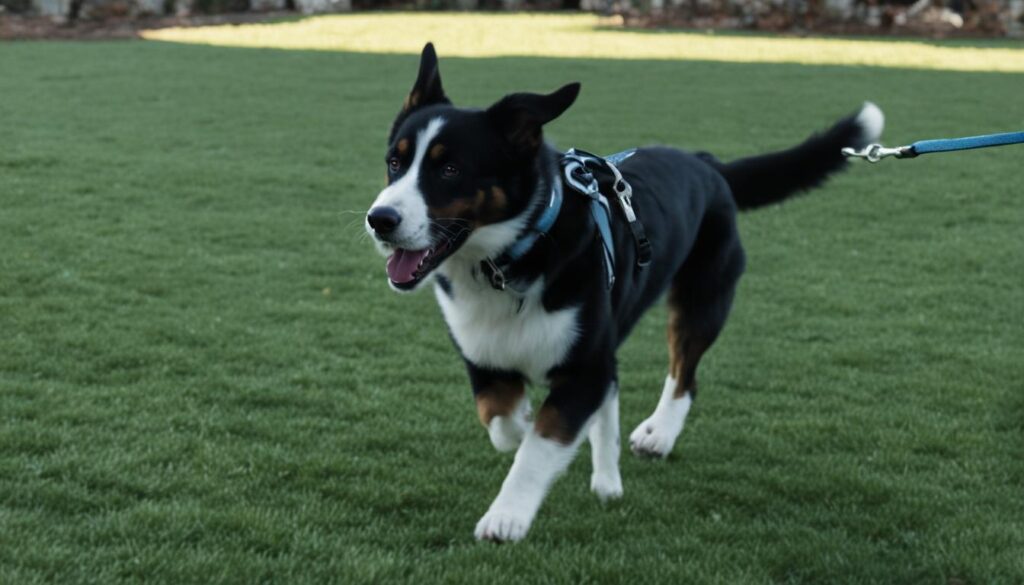
Dogs pulling on the leash is a common issue that many pet owners face during walks. To effectively address this behavior, it is important to understand why dogs pull on the leash in the first place.
One of the primary reasons dogs pull on the leash is because it allows them to reach their desired destination or engage with things that interest them. This could include other dogs they want to greet, people they want to interact with, or objects they want to investigate in the environment. Pulling on the leash gives them the freedom to explore and satisfy their curiosity.
Another reason for leash pulling is excitement. Dogs are naturally enthusiastic creatures, and the anticipation of going for a walk can trigger their excitement, causing them to pull out of sheer exuberance.
Additionally, dogs may pull on the leash because they want to walk at a faster pace than their handlers. They may have a strong desire to get to a specific location or experience the exhilaration of running, leading them to pull against the leash.
In some cases, leash pulling can also be a result of a lack of leash manners training. If a dog has not been taught proper leash walking skills, they may not understand the concept of walking calmly on a loose leash.
Understanding these underlying reasons for leash pulling is crucial in order to address the behavior effectively. By identifying the specific cause, pet owners can implement targeted strategies to modify their dog’s pulling behavior and encourage walking on a loose leash.
Implementing consistent training techniques and using appropriate equipment can help curb leash pulling behavior. In the next section, we will explore strategies to get started with leash training and teach your dog to walk nicely on a leash.
Getting Started with Leash Training
Before embarking on leash training for your dog, it’s important to ensure they are in the right physical and mental state. Providing your furry friend with enough exercise and mental stimulation will help them stay calm and focused during training sessions.
Choose the appropriate equipment to set your dog up for success. A comfortable leash and a well-fitting collar or harness will ensure your dog feels secure and comfortable while they learn to walk nicely on a leash.
If you’re training in an unstructured environment, such as a wide-open space, consider using long lines. These provide a sense of freedom for your dog while still maintaining control and ensuring their safety.
Creating a solid foundation of exercise, mental stimulation, and exploration will help establish the right mindset for leash training and make the process more enjoyable for both you and your canine companion.
| Getting Started with Leash Training | Recommended Actions |
|---|---|
| 1. Exercise and Mental Stimulation | Ensure your dog has had enough physical exercise and mental stimulation before training sessions to promote calmness and focus. |
| 2. Equipment Choice | Select a comfortable leash and a well-fitting collar or harness for your dog’s comfort and safety during training. |
| 3. Consider Long Lines | If training in an unstructured environment, use long lines to provide your dog with some freedom while still maintaining control. |
| 4. Foundation Building | Establish a solid foundation of exercise, mental stimulation, and exploration to create the right mindset for leash training. |
Choosing the Right Equipment
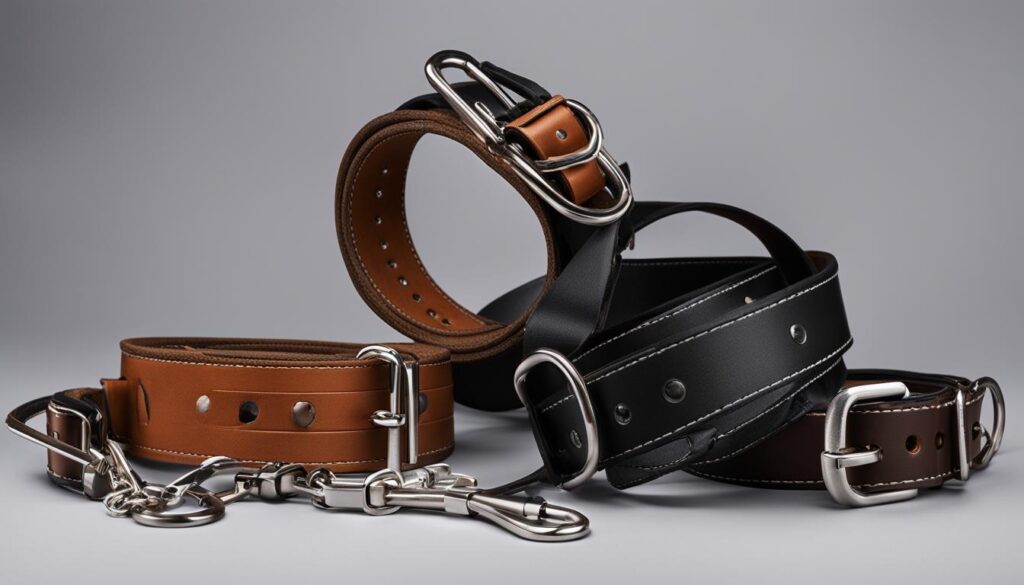
When it comes to leash training, selecting the right equipment is crucial for the comfort and safety of both you and your furry friend. Let’s take a look at the different types of leashes, collars, and harnesses that are best suited for leash training.
Types of Leashes for Dogs
When choosing a leash, opt for one that is 6-10 feet in length. This allows your dog enough freedom to explore while still maintaining control. Look for a leash that feels comfortable in your hands and is made from durable materials. Avoid retractable leashes, as they can cause injuries such as friction burns and are difficult to control.
Collars and Harnesses for Leash Training
For collars, a plain, flat collar is recommended. Ensure that the collar is fitted properly and cannot be slipped over your dog’s head. Avoid using training collars that rely on causing pain, as they can be harmful and deter positive training methods.
Instead, consider using harnesses for leash training. Harnesses provide more control and distribute the pressure evenly across your dog’s body, preventing chafing and discomfort. Look for harnesses with an easy on-off design and multiple leash attachment points, allowing you to choose the most suitable position for leash training.
Implementing the right equipment is an essential step in ensuring a successful leash training journey. It guarantees your dog’s safety, comfort, and overall well-being, enabling you to focus on teaching them proper leash manners and enjoyable walks together.
| Leash Type | Pros | Cons |
|---|---|---|
| Standard Leash | Provides control and simplicity | May cause strain if your dog pulls |
| Retractable Leash | Allows more freedom for your dog | Can cause injuries and difficulties in controlling your dog |
| Slip Lead | Easy to put on and take off | Might tighten too much if not used correctly |
| Chain Leash | Durable and strong | Can be heavy and uncomfortable |
The A-B-C Method for Understanding Leash Pulling
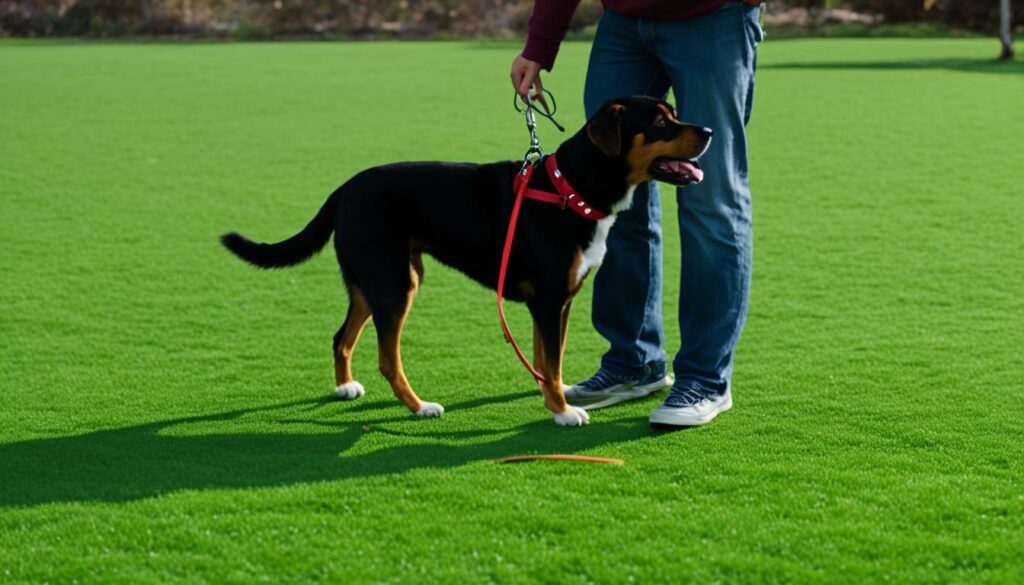
The A-B-C method (Antecedent-Behavior-Consequence) is a valuable tool for understanding why dogs pull on the leash. By analyzing the antecedents, behavior, and consequences of leash pulling, we can gain insight into the underlying causes and take appropriate measures to modify this behavior.
Antecedents: Antecedents are events or stimuli that occur before the pulling behavior. It could be triggered by spotting something of interest, encountering other dogs or people, or simply the desire to explore the surrounding environment.
Behavior: The pulling behavior itself refers to the act of the dog straining against the leash, seeking to move ahead faster or in a different direction than the handler.
Consequences: Consequences are the immediate results or outcomes of the behavior. In the case of leash pulling, it may result in moving closer to the desired object, reaching a specific location, or experiencing some form of excitement or reward.
By identifying the antecedents and consequences of leash pulling, we can modify them to change our dog’s behavior. For example, if the antecedent is seeing another dog, we can create distance or redirect attention before the pulling behavior occurs. Similarly, we can reinforce loose leash walking and reward alternative behaviors to shape a more desirable response.
The A-B-C method empowers us to understand the root causes of leash pulling and develop effective strategies to address the issue. By modifying the antecedents and consequences, we can guide our dogs towards more controlled, enjoyable, and well-behaved leash walking experiences.
Teaching Loose Leash Walking with Foundation Skills

To prevent leash pulling and develop the foundation skills for loose leash walking, it is essential to start training your dog in a non-distracting environment. By using positive reinforcement techniques, you can reinforce the behavior of walking with a loose leash.
One effective method to encourage your dog to stay close to you and maintain a loose leash is to incorporate the A-B-C method mentioned earlier. Use treats as rewards to reinforce the desired behavior. When your dog walks calmly by your side with a loose leash, praise and reward them with a treat.
In addition, practice luring techniques to encourage your dog to follow the treat hand while keeping the leash loose. Use a cue word or phrase, such as “let’s walk,” to signal the start of a loose leash walking session. This helps establish clear communication with your dog and sets the expectation for walking calmly and politely on a leash.
| Foundation Skills for Loose Leash Walking | Benefits |
|---|---|
| Focus and Attention | Helps your dog stay engaged with you during walks and reduces distractions |
| Loose Leash Positioning | Teaches your dog to walk by your side without pulling |
| Slow Pace | Encourages your dog to match your walking pace, creating a harmonious experience |
By consistently practicing these foundation skills and rewarding your dog for maintaining a loose leash, you can establish the groundwork for successful loose leash walking. As your dog becomes more comfortable and proficient, gradually introduce distractions and challenging environments to further reinforce their loose leash walking skills.
Expert Tip:
Avoid excessive leash corrections or punishments during training, as they can create a negative association with walking on a leash. Positive and reward-based training methods are more effective in building a strong foundation for loose leash walking.
Dealing with Leash Pulling Behavior
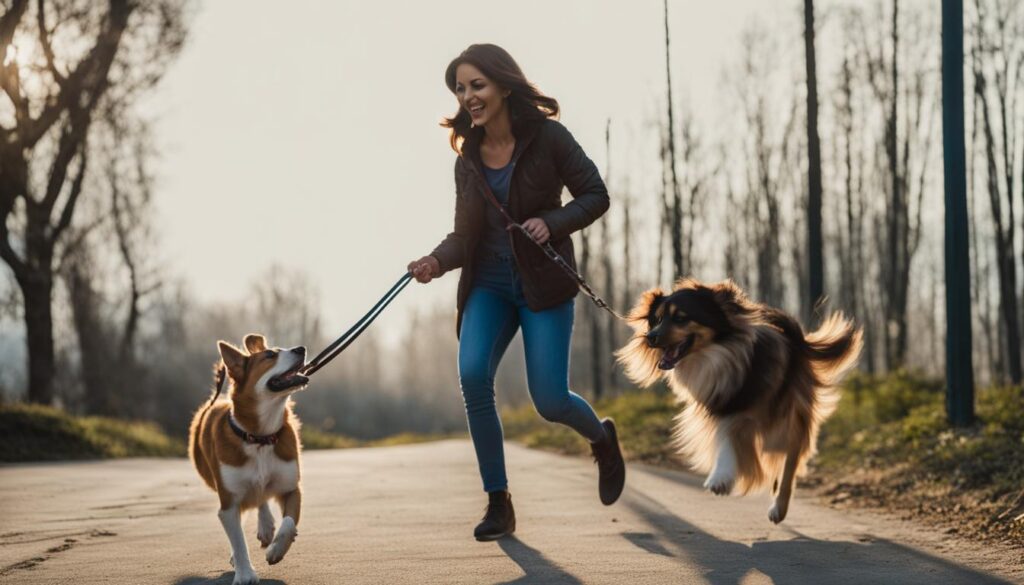
When it comes to handling leash pulling, it’s important to address the behavior and redirect your dog’s attention. There are a couple of effective training methods that can help teach your dog not to pull on the leash.
- Method 1: Stop and Wait
- Method 2: Change Direction
This method involves stopping immediately when your dog starts pulling on the leash. Wait for the leash to slack before you continue walking forward. By doing so, you are teaching your dog that pulling on the leash will not result in moving forward. Be patient and consistent with this training method to reinforce that pulling is not desirable behavior.
Another approach is to turn and walk in the opposite direction when your dog pulls on the leash. This momentary change in direction can help redirect your dog’s focus and disrupt the pulling behavior. By briefly putting your dog behind you, you reinforce the idea that pulling will not get them where they want to go. Be consistent with this method and always reward your dog when they walk calmly by your side.
Remember that both of these training methods require patience and consistency. It may take time for your dog to understand the desired behavior, so it’s important to stay committed to the training process.]
Here’s an important reminder:
“Training your dog not to pull on the leash requires consistency and positive reinforcement. By using these training methods and rewarding desired behaviors, you can teach your dog to walk calmly by your side.”
There are several factors that can contribute to leash pulling behavior, such as excitement or a lack of leash manners training. By addressing the behavior and using effective training methods, you can help your dog develop good leash manners and make your walks more enjoyable for both of you.
| Pros | Cons |
|---|---|
| Effectively interrupts leash pulling behavior | Consistency and patience are required |
| Redirects your dog’s attention | May take time for your dog to learn the desired behavior |
| Teaches your dog that pulling on the leash won’t result in moving forward | Requires ongoing training and reinforcement |
Consistency and Persistency in Leash Training
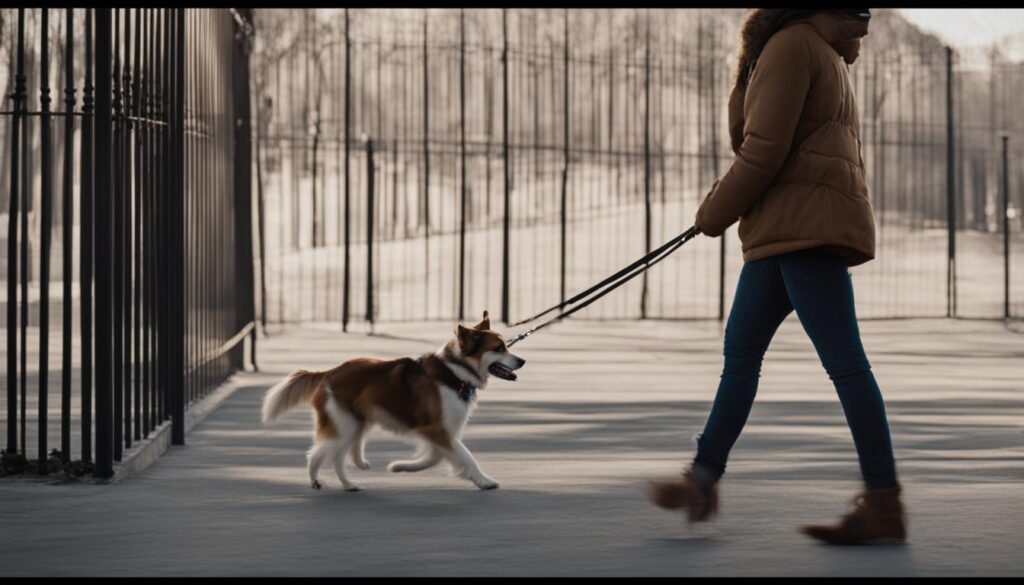
When it comes to leash training, consistency and persistency are essential for achieving success. By consistently following your training plan and persistently practicing the desired behaviors, you can effectively teach your dog to walk on a loose leash.
The Importance of Consistency
Consistency is key in leash training. Dogs learn through repetition and reinforcement, so it’s important to consistently apply the training techniques you have established. By providing clear and consistent expectations, you can help your dog understand what behaviors are desired during walks.
Consistency also extends to your rewards and reinforcement. When your dog displays the desired behavior, be sure to provide immediate praise, treats, or other rewards. This reinforces the positive behavior and encourages your dog to repeat it in the future.
The Power of Persistency
Leash training takes time and patience. It’s important to remember that learning to walk on a loose leash is a skill that may take several months for your dog to master. During this time, it’s crucial to remain persistent in your training efforts.
Consistently practice leash training with your dog on a regular basis, even if progress seems slow. By persistently reinforcing the desired behaviors and consistently correcting any pulling on the leash, you are helping your dog develop good leash manners over time.
Remember to stay patient and persistent throughout the training process. Each dog is unique and may require a different amount of time to learn. Celebrate small milestones and keep your expectations realistic, knowing that progress will come with time and dedication.
Consistency and persistency are the cornerstones of successful leash training. By consistently practicing the desired behaviors and persistently reinforcing those behaviors, you can help your dog learn to walk on a loose leash with confidence and ease.
Group Classes for Leash Walking
Group classes for leash training are highly recommended for refining your dog’s leash walking skills. These classes provide a controlled environment where you can work on your dog’s walking techniques under the guidance of a professional training coach. The expertise of a coach can help you develop excellent timing, manage distractions effectively, and modulate the training experience with different stimuli.
Attending group classes offers numerous advantages. Firstly, you get to practice leash walking with other dogs, which helps your dog learn proper social skills and respond to various canine behaviors. Additionally, these classes allow you to observe and learn from experienced trainers, helping you gain valuable insights and techniques for successful leash walking.
During group classes, you will have the opportunity to work on real-life scenarios and challenges that you may encounter during walks. This practical approach helps your dog generalize their training to different environments and distractions, making them more reliable on leash. The controlled environment also ensures the safety of all participants.
The professional training coach in these group classes can tailor the training sessions based on the specific needs of each dog and handler. Whether you’re dealing with leash pulling, reactivity, or other leash-related issues, the coach can provide individualized guidance and support to address these challenges effectively.
Remember, consistency and practice are key in leash training. By participating in group classes, you can establish a routine and dedicated time for leash training, which will greatly contribute to your dog’s overall progress. Take advantage of these valuable resources and seize the opportunity to enhance your leash walking skills alongside your furry companion.
Benefits of Exercise Before a Walk
Exercise plays a crucial role in preparing your dog for a walk, and it offers numerous benefits for loose leash walking. By engaging in vigorous exercise or play sessions before a walk, you can effectively drain your dog’s excess energy, which in turn reduces the likelihood of pulling on the leash during the walk. This is especially important for high-energy breeds or dogs with a lot of pent-up energy.
When your dog is properly exercised before the walk, they are more likely to stay calm and focused. This makes it easier for you to reinforce good leash manners and prevent leash pulling behavior. With a tired and content dog, you can establish better control and communication, allowing for a more enjoyable and stress-free walking experience.
Additionally, pre-walk exercise provides mental stimulation, which is just as important as physical exercise. Mental stimulation helps to keep your dog’s mind engaged and prevents them from becoming easily distracted during the walk. By combining physical and mental exercise, you can create a foundation for better on-leash behavior and promote overall obedience.
“Exercise before a walk helps to drain your dog’s excess energy, keeping them calm, focused, and more responsive to your instructions.”
Remember, exercise before a walk should be tailored to your dog’s age, breed, and physical abilities. Consult with your veterinarian or a professional dog trainer to determine the appropriate amount and type of exercise for your specific pet.
By incorporating regular exercise into your dog’s routine and prioritizing it before walks, you can set the stage for successful loose leash walking and a closer bond with your furry companion.
Setting Your Dog Up for Success
To set your dog up for success in leash training, it is crucial to create a conducive environment that promotes good leash manners and minimizes distractions. By carefully choosing the timing and route of your walks, you can significantly improve the effectiveness of your leash training sessions.
Firstly, avoid peak hours when planning your walks. During these times, streets and parks tend to be crowded, which can increase the chances of your dog getting easily distracted or overwhelmed. Instead, opt for quieter times of the day when there are fewer people and dogs around. This will allow you to focus on your dog’s training and minimize the likelihood of leash pulling.
Secondly, select routes that are less stimulating for your dog. Choose areas with fewer distractions such as busy roads, bustling shops, or popular hangout spots. Opt for peaceful parks, quiet residential areas, or nature trails where your dog can stay more focused on the training session. By minimizing external stimuli, you can create a serene environment that enhances your dog’s attention and responsiveness.
Another helpful strategy is to plan out-and-back routes for your walks. This means walking a certain distance in one direction, then turning around and retracing your steps to return home. It allows you to control the environment and gradually increase the difficulty level of the training. By consistently practicing familiar routes, your dog will become more familiar and comfortable with the surroundings, making it easier to reinforce good leash manners.
Remember, every dog is different, and what works for one may not work for another. Pay attention to your dog’s behavior and adjust your walks accordingly. By setting up the right environment, you can increase the chances of success in your leash training journey and enjoy pleasant and stress-free walks with your furry companion.
| Benefits of setting up a conducive environment for leash walking | |
|---|---|
| 1. | Reduced distractions leading to improved focus and attention. |
| 2. | Enhanced ability to reinforce and reward desired leash manners. |
| 3. | Increased comfort and calmness during leash training sessions. |
| 4. | Reduced likelihood of leash pulling behavior. |
| 5. | Improved training consistency and better outcomes. |
Wrapping Up
By implementing the right techniques, you can effectively stop your dog from pulling on the leash. It all starts with understanding the reasons behind their leash pulling behavior. Dogs pull because they want to explore their surroundings and move at their own pace. Once you understand this, you can choose appropriate equipment, such as a well-fitted collar or harness, and a comfortable leash.
To stop leash pulling, consistency is key. Use positive reinforcement techniques, rewarding your dog for walking calmly by your side and keeping the leash loose. It may take time and patience, but with consistent training, your dog will learn to walk politely on a leash.
Remember to prioritize your dog’s exercise and mental stimulation needs. A tired dog is less likely to pull on the leash, so make sure to provide them with regular physical exercise and mental enrichment. By meeting their needs, you’ll set them up for success during leash training.
With these effective techniques, you can enjoy stress-free walks with your furry friend. Say goodbye to leash pulling and hello to enjoyable, relaxed walks together.
FAQ
How can I stop my dog from pulling on the leash?
You can stop your dog from pulling on the leash by implementing effective leash training techniques. This involves understanding why dogs pull on the leash, choosing the right equipment, teaching foundation skills for loose leash walking, and addressing leash pulling behavior with consistent training methods.
Why do dogs pull on their leash?
Dogs pull on their leash because they want to engage with their environment, reach their desired destination, or have not been trained on proper leash manners. Pulling can be a result of excitement, wanting to go faster than the handler’s pace, or a lack of training.
How do I get started with leash training?
To get started with leash training, ensure your dog’s exercise and mental needs are met before training. Choose appropriate equipment such as a comfortable leash and a well-fitting collar or harness. Teach your dog foundation skills for loose leash walking in a non-distracting environment and use treats to reinforce the behavior.
What equipment should I use for leash training?
Choose a leash that is comfortable in your hands and is 6-10 feet in length. Opt for a collar or harness that fits properly and does not cause chafing. Avoid training collars that rely on causing pain. Consider using a harness with multiple leash attachment points for added control.
How does the A-B-C method help in understanding leash pulling behavior?
The A-B-C method (Antecedent-Behavior-Consequence) is a helpful tool for understanding why dogs pull on the leash. It helps identify the events that occur before pulling, the pulling behavior itself, and the immediate results of the behavior. By identifying these factors, you can modify them to change your dog’s pulling behavior.
How can I teach my dog loose leash walking with foundation skills?
Start by teaching your dog foundation skills for loose leash walking in a non-distracting environment. Use treats to reinforce the behavior of walking with a loose leash. Incorporate the A-B-C method to reward your dog for staying close and keeping the leash loose. Practice luring techniques to encourage your dog to follow a treat hand while maintaining a loose leash.
How can I deal with leash pulling behavior?
When your dog pulls on the leash, interrupt the behavior and redirect their attention. You can stop and wait for the leash to slack before moving forward or turn and walk in the opposite direction to momentarily put your dog behind you. Consistency and patience are key in teaching your dog not to pull on the leash.
How important is consistency and persistency in leash training?
Consistency and persistency are crucial in leash training. It is important to consistently follow the training plan, reinforce desired behaviors, and persistently practice leash training for several months. It takes time and patience for a dog to learn to walk on a loose leash, but by staying consistent and persistent, you can achieve success.
Are group classes beneficial for leash walking?
Yes, group classes for leash walking can be beneficial. Attending these classes in a controlled environment allows a professional training coach to assist you in refining your dog’s leash walking techniques. They can provide guidance on timing, managing distractions, and modulating the training experience with different stimuli.
How does exercise before a walk help with leash training?
Providing vigorous exercise or play sessions before a walk helps drain your dog’s excess energy and reduces the likelihood of leash pulling. It helps your dog stay calm and focused during the walk, making it easier to reinforce good leash manners and prevent pulling behavior.
How can I set my dog up for success in leash training?
Set your dog up for success in leash training by carefully choosing the timing and route of your walks. Avoid peak hours and select routes that are less stimulating to minimize distractions. By planning walks when your dog is calmest and choosing out-and-back routes, you can create an environment that promotes good leash manners and reduces the likelihood of pulling.
What are some effective techniques to stop dog pulling on the leash?
By understanding the reasons behind leash pulling behavior, choosing appropriate equipment, implementing consistent training methods, and prioritizing your dog’s exercise and mental stimulation needs, you can effectively stop your dog from pulling on the leash. Reward and reinforce desired behaviors, and have patience and persistence throughout the training process.






